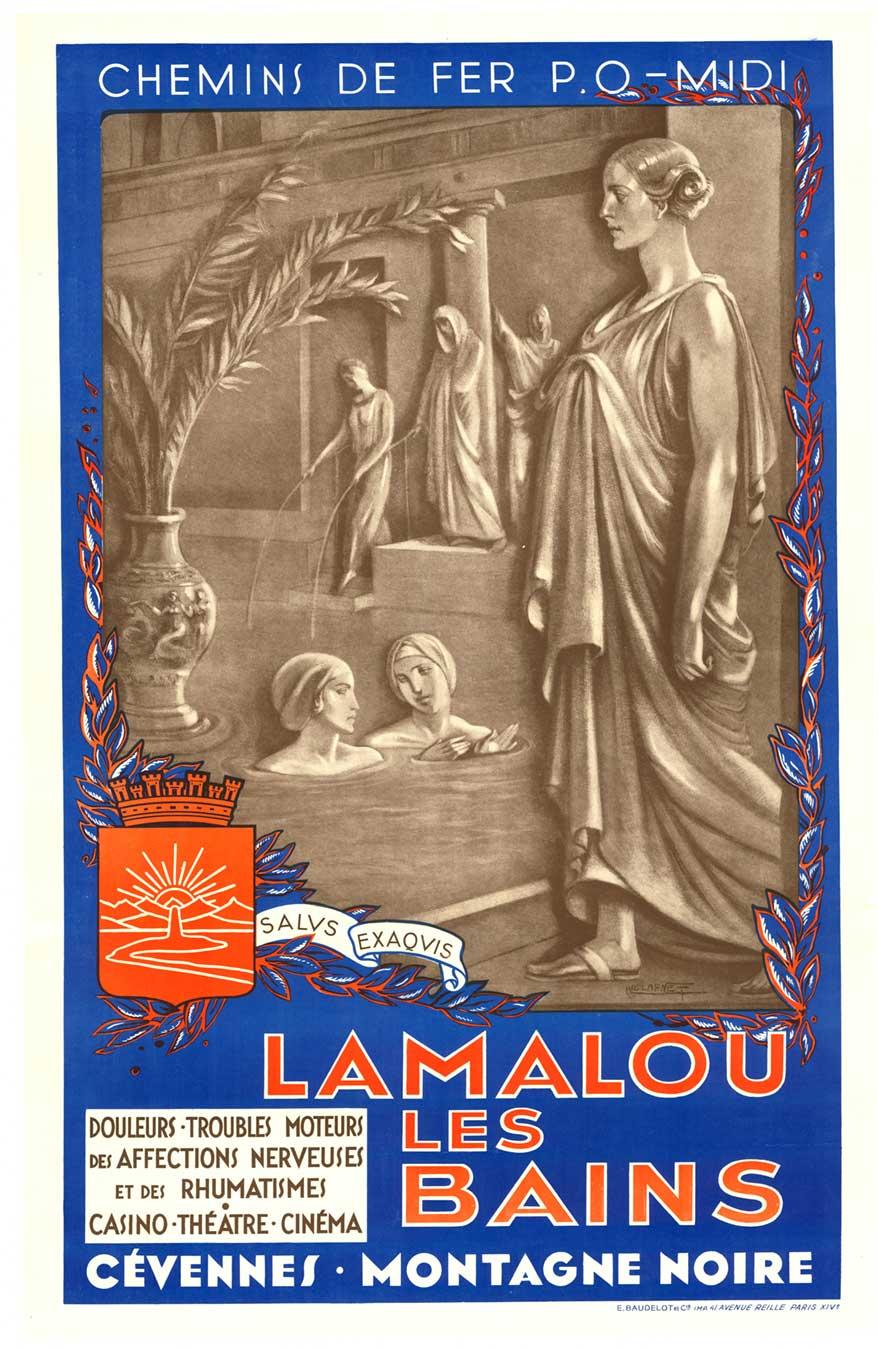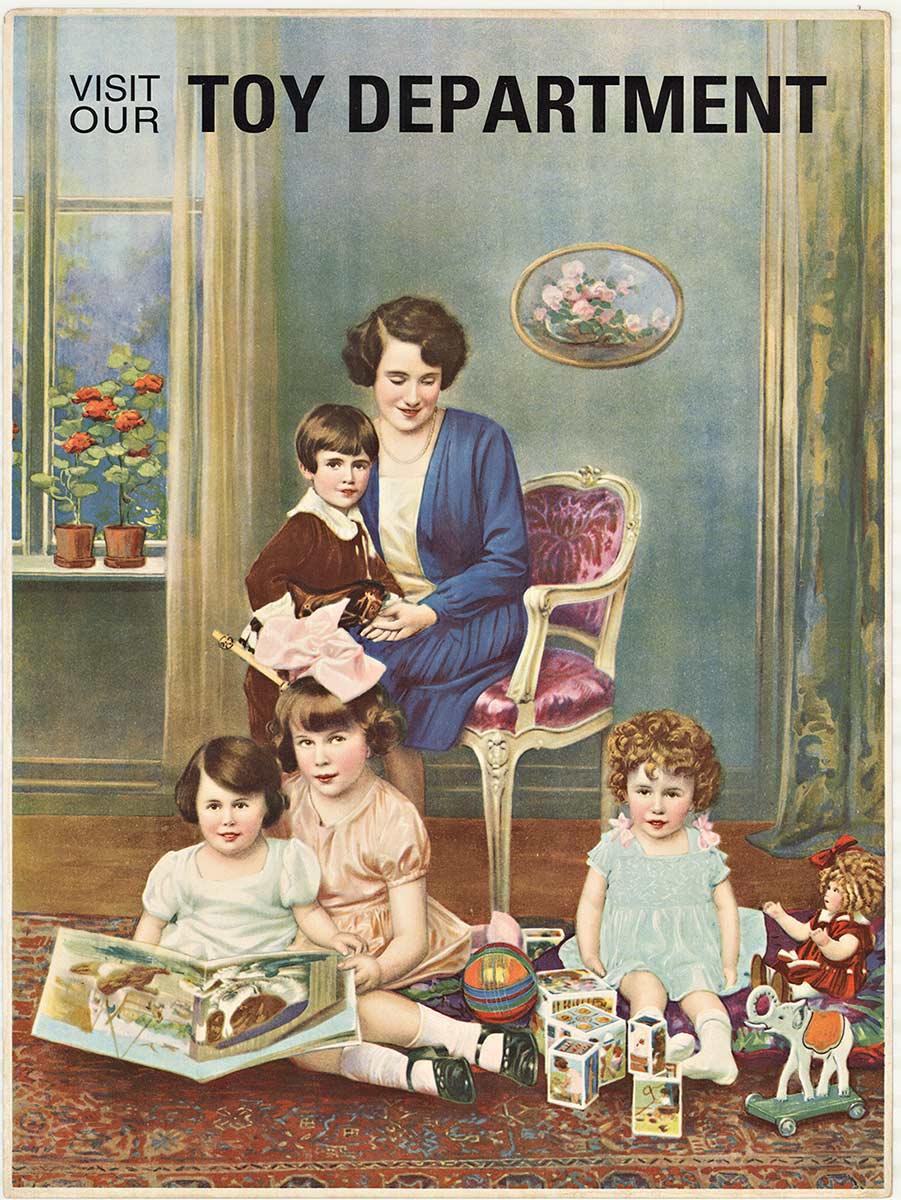Items Similar to Maurice Dufrene, Study, 3 Lithographs, 1906
Want more images or videos?
Request additional images or videos from the seller
1 of 8
Maurice DufrêneMaurice Dufrene, Study, 3 Lithographs, 19061906
1906
About the Item
Set of three lithographs enhanced with gouache by Maurice Dufrène. Three original plans of "Interieur Moderne d'une Famille Française" by Maurice Dufrene in 1906.
These three plans are the illustration of a study. The foreground shows a general view of the room; paneling, uprights, transom, bay, door, shelf, cartonnier and desk; waxed mahogany armchair, leather seat and back; drapery, berry, curtain, electric lamp and carpet. On the second, we zoom in on the corner bookcase, the tablet, the chair (all in waxed mahogany) and the fireplace (flamed sandstone, English copper gallery). On the third lithograph, you can see details of the office cabinet, the desk, the stained glass transom and the door. Lock and drawer handle in weathered copper too. The three plans are signed "Maurice Dufrène".
These plans are No. 8, No. 9, No. 10 of 18 which make up the entire illustration of this book.
The opportunities to acquire this type of works by Maurice Dufrène or any other renowned French Art Deco creator are more than rare. If you want to decorate your walls with these plans, all you need to do is select the frames that match your taste.
Dimensions of each plane: 52cm x 36cm (20.47 "x 14.17")
Condition - n ° 8: discolorations on the edges. n ° 9: slight discolourations on the edges. n ° 6: discoloration around the edges, fold on the bottom right corner, tearing of the bottom edge in the middle. n ° 10: discoloration on the edges, slight fold of the corner in the lower right, some freckles. Many of these defects will be hidden by the mat. Thank you for looking carefully at the pictures. Delivered without frame.
About Maurice Dufrène :
Maurice Dufrene was born in Paris in 1876. He studied at the Ecole des Arts Decoratifs,
In 1899, at the age of just 23, he became director and manager of La Maison Moderne, an association of artists who worked together to create designs which could be produced in multiples. These artists were van de Velde, Horta, Plumet and Selmersheim.
His work was first shown at salons in 1902, and from 1903 he regularly exhibited at Salon d’Automne and Salons of Société Nationale des Beaux-Arts. He quickly moved to the forefront of modern design and was with Leon Jallot, among the group of French designers which became known as the Constructeurs, before the First World War. Dufrene had worked on Meier-Graefe's 'La Maison Moderne' around 1900 designing in the Art Nouveau style.
By 1910, his work adapted more simplified forms using more substantial materials and construction. In 1904, he became a founding member of the Salon des Artistes Decorateurs, through which he exhibited for thirty years.
He taught for a while at Ecole Boulle, and returned to design in 1919 producing neat and logical designs embellished with recurring carved scroll motifs and decorated with marquetry floral medallions in boxwood, ebony and ivory.
In 1921 he joined the studio La Maîtrise, as Artistic Director, and began a period of prolific production. The full flowering of his talent became apparent in his refined furniture designs and complete interiors. His inspiration was taken from 18th and 19th Century designs, with a modern approach.
At the 1925 Exposition, Dufrene was everywhere. As well as the La Maitrise pavilion, he designed the 'petit salon' in the 'Ambassade Francaise', a boutique for the furrier Jungman, and the row of shoes on the Pont Alexandre Ill. Dufrene's stylistic development continued into the 1930s when he experimented with steel and glass.
Adapting quickly to the Art Deco movement, the 1930s were just as busy for him.
He died in Nogent-sur-Marne in 1955. His interiors ranged eclectically from townhouses to avant-garde to glass, metal and mirrors, to commissions from Mobilier National for embassies and the Palais de l’Elysée in Paris. He would remain at La Maîtrise until 1952. Today much of his work goes unidentified.
- Creator:Maurice Dufrêne (1876 - 1955, French)
- Creation Year:1906
- Dimensions:Height: 14.18 in (36 cm)Width: 20.48 in (52 cm)Depth: 0.01 in (0.1 mm)
- Medium:
- Movement & Style:
- Period:
- Condition:See description.
- Gallery Location:Saint Amans des cots, FR
- Reference Number:1stDibs: LU1088214046582
About the Seller
5.0
Vetted Seller
These experienced sellers undergo a comprehensive evaluation by our team of in-house experts.
1stDibs seller since 2018
34 sales on 1stDibs
- ShippingRetrieving quote...Ships From: Saint Amans des cots, France
- Return PolicyA return for this item may be initiated within 2 days of delivery.
More From This SellerView All
- Lady's Bedroom, Set of 4 Lithographs, 1906By Maurice DufrêneLocated in Saint Amans des cots, FRSet of four lithographs enhanced with gouache by Maurice Dufrene. Four original plans from "Interieur Moderne d'une Famille Française" by Maurice Dufrene in 1906. These four plans ar...Category
Early 1900s Art Nouveau Interior Prints
MaterialsLithograph
- James HARDY Jr. Charmeuse, Lithograph 135/350By James Hardy Jr.Located in Saint Amans des cots, FRLithograph titled "Charmeuse" by James Hardy Jr (1832-1889)., late 19th century. Numbered 135/350. Copyright by Galerie Lutetia, Notre-Dame-des-Victoires, Paris.Category
Late 19th Century Figurative Prints
MaterialsLithograph
- James Ward The Fisherman's FamilyBy James WardLocated in Saint Amans des cots, FRPrecious Watercolor attributed to James WARD (1769-1859) - England, 1830-1840. The Fisherman' S Family. Measurements : View : 20"x14.6" (51x37 cm), With frame : 26.6"x21.5" (67.5x54....Category
1830s Romantic Figurative Drawings and Watercolors
MaterialsPaper, Watercolor
- Dominique PERY, Marianne, Oil on canvas 1987Located in Saint Amans des cots, FROil on canvas by Dominique PERY, France, 1987. Nude named "Marianne". 73x60 cm - 28.75x23.6 in. 20F Format. Signed "D.Péry" lower right (see photo). Countersigned twice and dated 198...Category
1980s Neo-Expressionist Figurative Paintings
MaterialsCanvas, Oil
- Toujours la Vie RecommenceBy Edouard GoergLocated in Saint Amans des cots, FROil on canvas by Edouard Goerg (1893-1969), France, 1958. Life is always the same. Acquired in 2017 from the personal collection of Edouard Goerg. Measurements : with frame : 62.5x53...Category
1950s Expressionist Figurative Paintings
MaterialsCanvas, Oil
- Henri-André Martin Road in Eygalieres, Alpilles, Provence, Oil on Canvas, 1999By Henri-André MartinLocated in Saint Amans des cots, FROil on canvas by Henri-André Martin (1918-2004), France, 1999. Road in Eygalieres, Alpilles, Provence. With frame: 52x67 cm - 20.5x26.4 inches. Without frame: 46x61cm - 18.1x24 inches. Format 12P. Signed and dated lower left "Henri-André Martin 99" (see photo). Located on the back (see photo). Can be matched to make a pair with another painting by Henri-André Martin that we offer on 1stdibs whose title is "Henri-André Martin Road in the Alpilles, Provence, Oil on Canvas, 1980s". Born in Lyon in 1918, the child and the adolescent Henri-André Martin spent his youth in Saint-Étienne, his father, Edme Martin, first installed as a practicing doctor in Lyon, having been appointed doctor of the anti-tuberculosis dispensaries of the Loire. During his first years of studying medicine in Lyon, he nevertheless enrolled in the Beaux-Arts. Appointed hospital intern upon his return from captivity in 1942, he ended his medical career as director of the otolaryngology university clinic at Édouard-Herriot hospital. But painting was his passion. Painting was for Henri-André Martin the way of expressing his feelings. By nature very reserved and of an extreme modesty that many took for coldness, it was what allowed him to express his strong artistic sensitivity and, his pictorial periods are as many reflects of his anxieties, of his hopes, of his joys. At every period of his life, wherever he goes and whenever he has a moment, he paints gouaches, often of small size, but sometimes of larger size. He also paints beaches that have been compared to those of Boudin. Their invoice shows, however, that this figure is only appearance and that in fact, these beaches made of water, sky and sand, readily dispense with the motif, the work of the material seeming to have more importance. as the subject. Despite the fact that until the 1970s he painted "on the ground", his canvases remain far removed from the anecdote. Often harsh like the landscapes of Provence, the Parisian walls which express concern, or the railways, the switch tracks which suggest, in ocher and black, all the embarrassment of choice. We find the same nostalgic gravity in the canvases of the carcasses of boats which, as his friend Louis Pons later wrote, "seem to die of immobility" or in the canvases of Venice, or the landscapes of Eygalières. In the following years, his painting became simpler, more synthetic, such as these landscapes with tortured almond trees, black and gnarled olive trees, plane trees standing out against the ocher sky of the dawn of Provence, in winter. These are also the canvases of Hamburg in the dough becomes heavier, the colors darken, marking all the gravity of the port landscapes. Workshop work gradually takes precedence over motif painting. The pivotal period coincides with that of his work on the olive tree, during which he leads the realization of the "Trunks", a collection of six lithographic plates, of the book L'olivier comprising many lithographs and serigraphs, but also texts. poetic and numerous paintings. He then became passionate about everything related to the olive tree (literature, painting, traditions, history), but also to the tree itself, its thousand-year-old history, its poetry, its symbols, but also its culture, its size. oil production...Category
1990s Post-Impressionist Figurative Paintings
MaterialsCanvas, Oil
You May Also Like
- Original La Malou les Bains vintage French thermal spa posterBy Luc LafnetLocated in Spokane, WAOriginal poster: LAMALOU LES BAINS. CEVENNES - MONTAGNE NOIRE. Linen-backed old original French spa poster. Excellent condition. Statues look at t...Category
1920s Art Nouveau Still-life Prints
MaterialsLithograph
- Original 'Penelope" vintage 1913 opera posterLocated in Spokane, WAOriginal linen-backed stone lithograph opera poster for Penelope. Done in 1913 by the great lithographer Georges Rochengrosse who created several opera ...Category
1910s Art Nouveau Figurative Prints
MaterialsLithograph
- Visit our Toy Department original vintage chromolithograph posterLocated in Spokane, WAOriginal vintage poster: TOY DEPARTMENT. Chromolithographed illustration of a mother and four young children surrounded by a ball, blocks, and dolls, and with two young girls reading a book. No publishing information, but with a Shirley Temple doll...Category
1920s Art Nouveau Interior Prints
MaterialsLithograph
- Original Wallpapers and Decorations John Gilkes & Sons vintage posterLocated in Spokane, WAWallpapers and Decorations John Gilkes & Sons. Original stone lithograph. Size: 31" x 47". C. 1915 - 1920. Printer: J.J. Keliher & Co., London Archival linen backed authentic antique poster...Category
1910s Art Nouveau Figurative Prints
MaterialsLithograph
- Au Bain, Signed Lithograph by Rene GruauBy René GruauLocated in Long Island City, NYArtist: Rene Gruau, Italian (1909 - 2004) Title: Bather Year: circa 1990 Medium: Lithograph on Japon, signed and numbered in pencil Image Size: 20 x 15 inches Frame Size: 27 x 20 inchesCategory
1970s Art Nouveau Interior Prints
MaterialsLithograph
- Von Der Pflanze Zum OrnamentLocated in Wilton, CT30 plates of floral designs from the Jugendstil periodCategory
Early 1900s Jugendstil Interior Prints
MaterialsLithograph
Recently Viewed
View AllMore Ways To Browse
Refined Furniture
Antique Study Print
Antique Furniture Interior Design
Art Deco Interiors
Antique Style Interior
Eclectic Interiors
Modern Antique Interior
Antique French Interior Design
Modern Interior Doors
18th Century Lithograph
Cabinet Mirrored Interior
Antique Interior French Doors
Interior Doors Antique Style
Antique Director Chair
Antique Directors Chair
Antique Directors Chairs
Antique Interior Glass Doors
Antique Interior Door With Glass



